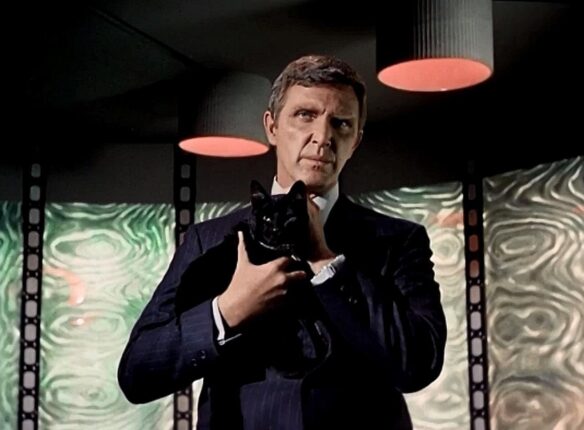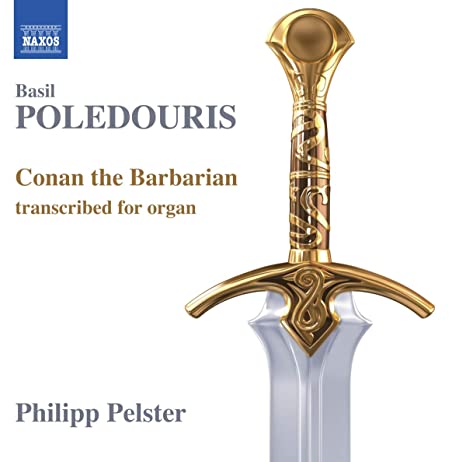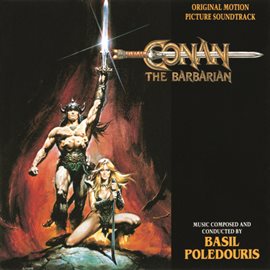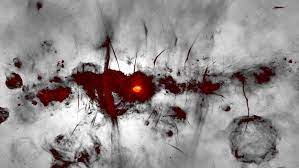(1) WRONG IMMORTALS? At Speculiction Jesse Hudson declares “Close But No Cigar: Response to Library of America’s Nine Classic Science Fiction Novels of the 1950s”.
A decade ago, the Library of America released the set Nine Classic Science Fiction Novels of the 1950s. The series was edited, or perhaps more accurately, curated by Gary Wolfe. Wolfe is a genre personage who I often disagree with, but a person who I respect, particularly his knowledge of 20th century science fiction. Wolfe is a proper scholar and a person to be trusted when looking to curate such a series. Nevertheless, differences in opinion there are, and it’s in those differences that my views have been percolating for ten years, waiting until I’ve read enough sf from the 50s to have an informed rebuttal. With more than thirty-five novels from the decade under my belt (and this post sitting in my drafts folder for all that time) I think I’ve reached that point. In the very least I will introduce you to some old school science fiction that perhaps wasn’t on your radar before…
The nine novels Wolfe selected were: Frederik Pohl and C. M. Kornbluth’s The Space Merchants; Theodore Sturgeon’s More Than Human; Leigh Brackett’s The Long Tomorrow; Richard Matheson’s The Shrinking Man; Robert A. Heinlein’s Double Star; Alfred Bester’s The Stars My Destination; James Blish’s A Case of Conscience; Algis Budrys’ Who?; and Fritz Leiber’s The Big Time
Hudson doesn’t disagree with all of Wolfe’s picks, and sometimes the reasons for disagreement are highly nuanced. For example:
Theodore Sturgeon’s More than Human – Sturgeon is one of the great voices of the 50s and fully deserving of a place in the volume. But I have qualms about More Than Human. Style-wise, it’s impeccable. American science fiction writers rarely produce prose of such amazing quality, even today. The first Act of More than Human reads like a mythic dream. Substance-wise, however, it’s less amazing. The book’s conception, that humanity could evolve and exist in harmony via telekinetic gestalt, is a few steps over the line. Spaceships, blasters, and aliens one can consider, telekinesis less so. To be fair, telekinesis was a common device of the time; it was something closer to ‘possible’ than it is today. But the most important reason I have qualms is I do not think More Than Human is Sturgeon’s best book of the 1950s. Stay tuned.
And among the books Hudson would have picked instead is this one:
James Blish’s They Shall Have Stars – First novel in the Cities in Flight tetralogy, They Shall Have Stars may be the quintessential expression of Modernist human hopes (expectations?) for the stars. The book contains a fair bit of drama, but rather than alien encounters, space ship blasters, or laser pistols, the book focuses on the human aspect of leaving Earth for space: finances, technology, pharmaceuticals, socio-economics, etc. It’s literally anti-pulp. Blish tries to be realistic in his presentation of the possibilities (or lack thereof) for human life beyond our stratosphere, and should be lauded for it. I just think A Case of Conscience is the better novel given how transcendent the theme is.
(2) OUR FANTASTIC PAST. Shannon Chakraborty tells New York Times readers “Historical Fantasy Novels Offer a Magical Escape Into the Past” and lists several favorites. The article is behind a paywall so we can’t share the notes, but we can name the titles.
People have been telling fantastical tales about the past since, well … most likely long before our ancestors began painting caves with wild beasts that danced in the firelight. A ragtag collection of Bronze Age skirmishes is transformed into the Trojan War, where gods meddle and great heroes are dispatched on quests we’re still retelling. Alexander the Great, already pretty remarkable, ends up a larger-than-life character in romance tales across Africa, the Middle East, Europe and Asia that have him battling centaurs and searching for the fountain of life (inspired by even older tales of Gilgamesh). If the past were a foreign country, clearly a great number of us would be eager to plan a trip….
The recommended books are: Lavinia by Ursula K. Le Guin; She Who Became the Sun by Shelley Parker-Chan; The Bird King by G. Willow Wilson; The Pasha of Cuisine; by Saygin Ersin; A Master of Djinn by P. Djèlí Clark; Moonshine by Alaya Johnson; Gods of Jade and Shadow by Silvia Moreno-Garcia; Siren Queen by Nghi Vo; and Flying Snakes and Griffin Claws by Adrienne Mayor.
(3) WOULD YOU LIKE TO KNOW MORE? El País writer Miquel Echarri, very much a fan of the Verhoeven version, is alarmed by Sony’s announcement they want to remake the film — “’Starship Troopers’: The $100-million movie adaptation of a ‘very right-wing book’”.
Science fiction cinema has presented us with two genocides, both met by their indirect victims with startling indifference. The first occurs in Star Wars: Episode IV – A New Hope, where Alderaan — no mere lost island or remote desert village, but an entire planet with millions of inhabitants — is destroyed. In what Wookieepedia describes as “one of the most cruel and vile acts of the Galactic Empire,” Grand Moff Tarkin, admiral of the Death Star, obliterates an entire celestial body in an instant, sending “an intense shock to the Force,” yet Leia Organa, princess of Alderaan, accepts the annihilation of her homeworld with remarkable stoicism.
The second catastrophe is the destruction of 23rd-century Buenos Aires in Starship Troopers. This time, the perpetrator is an arachnid force from outer space, which causes a mere mild annoyance in two of the film’s protagonists, Juan Rico (Casper van Dien) and Carmen Ibáñez (Denise Richards), both from Buenos Aires province. However, they curiously speak English. Argentine writer Jorge Luis Borges once described Buenos Aires as “as eternal as water and air,” but in Paul Verhoeven’s irreverent film, the city is erased from the map in an instant, without the slightest reverence….
… By the spring of 1996, Verhoeven knew he was putting his Hollywood career on the line with one final gamble, and that gamble was Starship Troopers. Given the circumstances, it seemed logical to follow what the production companies, TriStar Pictures and Touchstone, were asking of him: use the more than $100 million available to turn Heinlein’s novel into a fast-paced, straightforward action blockbuster. But Verhoeven and Neumeier insisted on taking a different approach — a balance between spectacle and sharp social satire, a path they had already explored together in RoboCop….
Anyone considering adapting Heinlein’s Starship Troopers at this point should be acutely aware that they’re dealing with sensitive, potentially radioactive material, and should not lose sight of Verhoeven’s example. Therefore, Columbia’s attempt to faithfully adapt the novel is, at the very least, questionable. What will remain of this formidable satire if you strip away the irony that gave it its meaning?
(4) WHAT’S YOUR TOP SF SCREEN MOMENT? ScreenRant nominates the “10 Most Epic Moments In Sci-Fi Movies”. What does it tell you about the heightened impact as you make your way up this list that this scene is only sixth!
6. Spock’s Death
Star Trek II: The Wrath Of Khan (1982)
What contributes to making Spock’s death such a pivotal scene, besides the performances given by both Nimoy and William Shatner as Captain Kirk, is the fact that it happens right under Kirk’s eyes. The relationship between Kirk and Spock has always been the core of Star Trek, and this scene, with Spock slowly succumbing to radiation poisoning just one clear door away from Kirk, brings that relationship to a new level of emotional closeness.
(5) MICHAEL COLLINS AWARD. The winners of the Michael Collins Trophy have been announced by the National Air and Space Museum. The award was established in 1985 and was renamed in honor of Apollo 11 astronaut Michael Collins in 2020.
LIFETIME ACHIEVEMENT
- MARGARET HAMILTON
Software engineer Margaret Hamilton played a pivotal role in 20th-century aerospace innovation, particularly through her contributions to Project Apollo. Leading the team that developed the onboard flight software for the Apollo missions, her meticulous work and groundbreaking approach to software design were crucial to the success of the Moon landings and fundamentally reshaped the field of software engineering. Hamilton’s expertise extended beyond Apollo to projects like Skylab and the Space Shuttle, and her legacy continues to influence modern aerospace software development while demonstrating the profound impact women engineers have had in the field.
CURRENT ACHIEVEMENT
- The OSIRIS-REx Team
NASA’s OSIRIS-REx mission marked a significant milestone by achieving the first U.S. asteroid sample return, securing the largest amount of material ever collected from beyond the Moon. After orbiting the ancient asteroid Bennu—earning a Guinness World Record for the closest orbit of a planetary body—the spacecraft successfully collected over 120 grams of rock and dust in 2020 and returned it to Earth in 2023. This precious sample, a “time capsule” from the early solar system, is now being analyzed by scientists worldwide (including at the Smithsonian) to uncover secrets about the origins of life on Earth, with preliminary findings already emerging.
(6) RETAILING THE WEIRD. Bobby Derie chronicles a certain kind of foreign agent in “Her Letters to August Derleth: Christine Campbell Thomson” at Deep Cuts in a Lovecraftian Vein.
… Thomson scored a small coup when she sold Derleth’s story “Hawk on the Blue” (based on a story in a letter from Robert E. Howard) for 8 guineas (although after various costs, this came out to a bank draft for $26.94). Other stories were met with various comments; Regarding “Muggridge’s Aunt,” Thomson wrote: “I am not quite certain whether it is horrible enough for Not at Night, the readers of which like their blood laid on with a soupladle” (Thomson to Derleth, 24 Sep 1934). About “Gus Elker and the Fox,” Thomson wrote “we feel that it is too American to place over here” (Thomson to Derleth, 12 Oct 1934)….
(7) IAN WILLIAMS (1948-2025). UK fan and sf writer Ian Williams died March 28. He had been hospitalized for a fall on March 16 and never recovered.
Ian Williams was especially well-known in the Seventies among international fanzine fans, not that he wasn’t prominent later.
He was a founding member of The Gannets, a club in the north-east of England formed after the 1970 Eastercon, which initially met at his house in Sunderland. First called the North East Fan Group (NEFG), when they switched to meeting at a subterranean pub called The Gannet Greg Pickersgill coined their new name, Gannetfandom, and so they were known thereafter. In addition to publishing fanzines, they ran several conventions. Besides Williams, other early members included Harry Bell, Ian Penman, Jim Marshall, Thom Penman, Ritchie Smith and Ian Maule.
Williams was the first editor of Maya (1970-1971).
His novel, The Lies That Bind, appeared in 1989.
He worked as a librarian. He was married, for a time, to Susan Hardy. His fondness for cats infused his Facebook posts, and he was a co-founder of an animal rescue charity.
[Based on Williams’ Fancyclopedia 3 entry.]
Rob Jackson adds: Ian was in effect the prime mover in founding the Gannets, though Harry Bell preceded him as active in fandom. Slightly later-arriving Gannets who are still active include – in chronological order – myself, Kevin Williams (no relation) and Dave Cockfield among others. The later editors of Maya were Ian Maule (1972-1975) and myself (1975-1978). Ian’s personalzine Siddhartha went through two incarnations: a traditional mimeo run in the Seventies and a much later online version.
(8) MEMORY LANE.
[Written by Cat Eldridge.]
March 29, 1968 – “Assignment Earth” Star Trek episode
Captain’s log. Using the light-speed breakaway factor, the Enterprise has moved back through time to the 20th century. We are now in extended orbit around Earth, using our ship’s deflector shields to remain unobserved. Our mission – historical research. We are monitoring Earth communications to find out how our planet survived desperate problems in the year 1968.
Fifty-seven years ago on this evening, Star Trek’s “Assignment: Earth” first aired on NBC as part of the second season. Guest starring Robert Lansing as Gary Seven and Terri Garr as Roberta Lincoln, our crew which has time-travelled to 1968 Earth for historical research encounters an interstellar agent and Isis, his cat, who are planning to intervene in Earth history.
It was directed by Marc Daniels whose first break in the business was directing the first thirty-eight episodes of I Love Lucy which was produced at the Desilu studio which became Paramount. This was one of fifteen Trek episodes he’d direct. He won a Hugo at NYCon 3 with Gene Roddenberry for Best Dramatic Presentation for “The Menagerie”.
The story is by Art Wallace and Gene Roddenberry. Wallace, who also did the teleplay, is best remembered for his work on the soap opera Dark Shadows. Oh, and he did some scripts for Tom Corbett, Space Cadet.
It was intended as a pilot for an Assignment: Earth series that Gene Roddenberry planned but that never happened. Roddenberry’s intent was that Lansing and Garr would continue in the series if it was commissioned, but since NBC was not involved in casting the backdoor pilot, it could and well might have been that NBC would have insisted on changes or even completely recast the series had it picked up.
Interesting note: The uncredited human form of Isis was portrayed by actress, dancer, and contortionist April Tatro, not Victoria Vetri, actress (in Rosemary’s Baby under the name of Angela Dorian) and Playboy Playmate of the previous year, as would become part of Trek lore. Her identity was unknown until 2019 when The Trek Files podcast cited a production call sheet for extras dated the fifth of January for the year of broadcast. For decades fans had believed that the very briefly seen human form of the cat Isis was portrayed by actress Victoria Vetri. Many articles and websites treat that belief as revealed truth. Recently Vetri herself confirmed that she was not in the episode. No idea why the rumor started.
Barbara Babcock, best remembered as Grace Gardner on Hill Street Blues, a most excellent series, was the Beta 5 computer voice (uncredited at the time) and she did the Isis’ cat vocalizations as well. Speaking of that cat, it was played by Sambo as you can see by this NBC memo. Interestingly Lansing though would later contradict that claiming that there were actually three black cats involved. I can’t confirm his claim elsewhere.
Though this backdoor pilot did not enter production as a television series, both Seven and Roberta were featured in multiple stories and they were spun-off into a comic book series from IDW Publishing, Star Trek: Assignment: Earth by John Byrne. And there was the excellent novelization of the episode that Scott Dutton did for Catspaw Dynamics. I’ve read it and it’s quite superb.
In addition, according to Memory Alpha, the source for all things Trek, “Seven and Lincoln have appeared in several Star Trek novels (Assignment: Eternity and the two-volume series, The Eugenics Wars: The Rise and Fall of Khan Noonien Singh by Greg Cox) and short stories (“The Aliens Are Coming!” by Dayton Ward in Strange New Worlds III, “Seven and Seven” by Kevin Hosey in Strange New Worlds VI and “Assignment: One” by Kevin Lauderdale in Strange New Worlds VIII).”
The plot concept of benevolent aliens secretively helping Earthlings was later resurrected by Roddenberry for The Questor Tapes film. That film was one of a series of television movies in which Roddenberry was involved — Genesis II, Planet Earth, Strange New World and Spectre. Need I say none made it past the stage of the initial television movie which served as a pilot?

(9) TODAY’S BIRTHDAY.
[Written by Paul Weimer.]
March 29, 1957 — Elizabeth Hand, 68.
By Paul Weimer: I once told Elizabeth Hand that I felt unqualified to read her books. She was gently bemused by this.

When I have engaged with her work, I have found Hand’s work incredibly literate, immersive, enthralling and syncretic. She pulls ideas, motifs, images, and ideas from everywhere, especially music and other arts, into her work. A lot of her characters and settings involve music, theater, creative folks in all sorts of guises. I didn’t quite bounce off Wylding Hall so much as I thought I didn’t get so much of it as would someone else more in tune and inclined to the musical arts, and the whole musical scene. Hand has a passion for infusing music and mythology and magic into her work. The Glimmering has a Christian rock singer as her protagonist in the middle of a climate change apocalypse. Waking the Moon dumps the reader into a world of a dark goddess, witchcraft and magic right from the world go. It felt like a dive into a deep pool trying to read the book.
The city of trees in the Winterlong books is surreal, chimerical, and has a main character who can walk in dreams. Maybe that’s the right metaphor for Hand’s work. A walk into her dreams, but with more sense and cohesion than actual dreams, but with the unusual skewed version of reality that one gets. Black Light, with its entry for the protagonist into a world of Gods and Monsters far more terrifying than the parties her godfather was throwing. That’s something of a slower burn than Waking the Moon, sometimes you get immersed into the pool rather than jumping into her worlds feet first.
But no matter which Hand book you read, be it in a sudden dive or by slow steps, she enthralls you with her myth, creation and magic. I still think I am not quite the right person to read her books (a theater kid with a passion for fantasy is, frankly, her target audience). But I still try, nevertheless, because her work is absolutely worth it.
(10) COMICS SECTION.
- Bliss finds the same easy pleasure some of you take from File 770.
- Brevity remembers the competition.
- Lio knows things.
- Off the Mark assembles.
- xkcd knows the back story.
(11) THIS ONE’S A HIT. Shawnerly tells of a checkered past when it comes to liking the works of T. Kingfisher. “#BookReview: A Sorceress Comes To Call |T. Kingfisher Horror |Feminism in the 1800’s” at She’s Reading Now.
…Things are touch and go with Kingfisher and I. I’ve DNF’d What Moves The Dead and What Feasts At Night. But, I thought, 2023’s A House With Good Bones, was a 4 star read! The issue is probably me. Sometimes I just don’t get her style of gothic horror storytelling. I keep trying though, and that should count for something! I finished her latest romp A Sorceress Comes To Call – and gave it 4 stars! Let’s chat about it!…
(12) FOR SEVERANCE FANS. “Apple’s Mac Site Features Fictional ‘Lumon Terminal Pro’”, but MacRumors cautions it’s a bait-and-switch.
Apple is going all out with promotions for the popular Severance Apple TV+ show today, and as of right now, you’ll find a new “Lumon Terminal Pro” listed on Apple’s Mac site.
The Lumon Terminal Pro is designed to look similar to the machines that Severance employees like Mark S. and Helly R. use for macrodata refinement. The Terminal features a blue keyboard, a small display with wide bezels, and a trackball for navigation purposes.
Unfortunately, you can’t actually buy a Lumon Terminal Pro, though it would undoubtedly sell well to Severance fans. Apple’s page links to the company’s actual Macs, and to a behind the scenes editing video that Apple shared this morning.

(13) CLEANING UP SPACE. Keep B.O. “far, far away” with “The Mandalorian 4-Pack + Soap Saver” from Dr. Squatch. (And that black thing below is not the monolith from 2001, that’s the “soap saver”.)



(14) IT’S OBVIOUSLY AN ATTACK FROM SPAAAAACE! [Item by Mark Roth-Whitworth.] ScienceAlert says “NASA Is Watching a Huge, Growing Anomaly in Earth’s Magnetic Field”.
NASA has been monitoring a strange anomaly in Earth’s magnetic field: a giant region of lower magnetic intensity in the skies above the planet, stretching out between South America and southwest Africa.
This vast, developing phenomenon, called the South Atlantic Anomaly, has intrigued and concerned scientists for years, and perhaps none more so than NASA researchers.
The space agency’s satellites and spacecraft are particularly vulnerable to the weakened magnetic field strength within the anomaly, and the resulting exposure to charged particles from the Sun.
The South Atlantic Anomaly (SAA) – likened by NASA to a ‘dent’ in Earth’s magnetic field, or a kind of ‘pothole in space’ – generally doesn’t affect life on Earth, but the same can’t be said for orbital spacecraft (including the International Space Station), which pass directly through the anomaly as they loop around the planet at low-Earth orbit altitudes.
During these encounters, the reduced magnetic field strength inside the anomaly means technological systems onboard satellites can short-circuit and malfunction if they become struck by high-energy protons emanating from the Sun.
[Thanks to Kathy Sullivan, Teddy Harvia, Mike Kennedy, Andrew Porter, John King Tarpinian, Chris Barkley, Cat Eldridge, SF Concatenation’s Jonathan Cowie, Mark Roth-Whitworth, and Steven French for some of these stories. Title credit belongs to File 770 contributing editor of the day Dan’l.]






